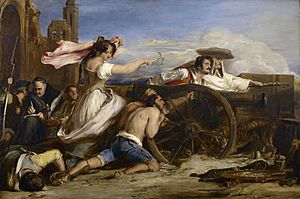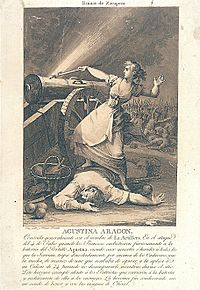Agustina de Aragón facts for kids
Quick facts for kids
Agustina Raimunda Maria Saragossa y Domènech
|
|
|---|---|
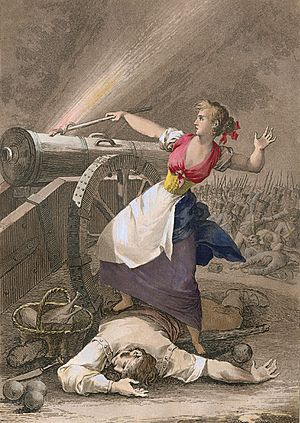
Agustina as depicted by Fernando Brambila
|
|
| Nickname(s) | Agustina de Aragón |
| Born | March 4, 1786 Reus, Catalonia, Spain |
| Died | May 29, 1857 (aged 71) Ceuta, Spain |
| Buried |
Nuestra Señora del Portillo
|
| Allegiance | |
| Service/ |
|
| Rank | Captain |
| Battles/wars | Peninsular War
|
| Awards | DEFENSORA DE ZARAGOZA RECOMPENSA DEL VALOR Y PATRIOTISMO |
Agustina Raimunda Maria Saragossa i Domènech (born March 4, 1786 – died May 29, 1857), also known as Agustina of Aragón, was a brave Spanish heroine. She played a key role in defending Spain during the Peninsular War. She started as a regular person and later became an officer in the Spanish Army. People often call her "the Spanish Joan of Arc" because of her courage. Her story has inspired many tales, myths, and artworks, including drawings by Francisco Goya and poems by Lord Byron.
Contents
The Siege of Zaragoza
In the summer of 1808, the city of Zaragoza was one of the last places in northern Spain that Napoleon's forces had not captured. Many people fleeing the French army, called the Grande Armée, came to Zaragoza for safety. The city had not seen war for about 450 years. It was defended by a small local army led by José de Palafox y Melci.
On June 15, 1808, the French army attacked the Portillo, an old gate into the city. This gate was defended by old cannons and a small group of volunteers. Agustina arrived with a basket of apples for the gunners. She watched as the Spanish defenders fell to French soldiers. The Spanish troops, having lost many fighters, left their positions.
With the French soldiers very close, Agustina bravely ran forward. She loaded a cannon and lit its fuse. The cannon fired, hitting many attackers from a very short distance.
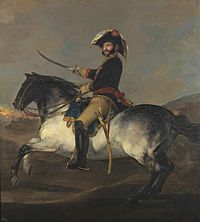
Seeing a single woman bravely firing the cannons inspired the Spanish troops. They and other volunteers returned to help her. After a tough fight, the French stopped their attack on Zaragoza. They left the siege for a few weeks but soon returned. This time, they fought their way into the city, house by house.
The fighting was very costly for both sides. The city's defenses were badly damaged. Finally, Palafox had to give up, and the city surrendered to the French. Even though Zaragoza was eventually defeated, Agustina's brave act became a symbol of hope for those fighting against the French.
Agustina was not a soldier at first. She was an ordinary person who became a hero because of the war. At that time, it was unusual for a woman to take on such a role. However, the Church said that every Spaniard should fight against the French. This was because the King of Spain, who was seen as chosen by God, was held prisoner by the French.
Agustina's exact birthplace is debated. Most stories say she was born in Reus, in Tarragona, in 1786. Her family later moved to Madrid. She was independent from a young age. Records show she often visited army barracks when she was only 13.
She married an artillery gunner named Joan Roca Vila-Seca. She later left him and returned to her sister's home in Zaragoza.
A Leader in the Resistance
Agustina's heroic act at Zaragoza is well-known, but she did even more later. After being captured by the French, she was imprisoned. Her son, Eugenio, died while she was imprisoned. Agustina then made a daring escape. She became a leader for the guerrilleros, who were small groups of rebels. She helped plan raids and attacks that bothered the French army.
As the French army's situation worsened, Agustina's role became more official. The Duke of Wellington secretly provided supplies and training to the Spanish fighters.
The Battle of Vitoria
Spanish stories say that Agustina fought for the allied forces. She was supposedly Wellington's only female "officer" and rose to the rank of captain. The legend says that on June 21, 1813, she commanded a group of cannons at the Battle of Vitoria. She was said to be under a Major "Cairncross," who reported directly to Wellington. However, historian Nick Lipscombe says these stories are not true in his book about Wellington's artillery. The Battle of Vitoria was a major defeat for the French army. It was largely destroyed and driven out of Spain.
Later Life and Death
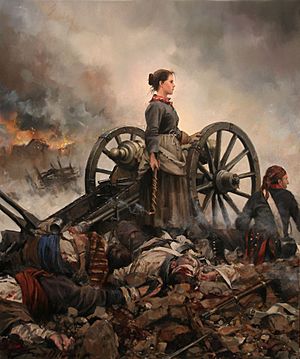
After the war, Agustina married a doctor. In her later years, she was a familiar sight in Zaragoza. She was a respected old lady who wore her medals and often walked around the Portillo. Agustina de Aragón passed away at the age of 71 in Ceuta. Her remains were first in the Church of Our Lady of the Pillar. In 1908, they were moved to the Chapel of the Annunciation in the Church of Our Lady (Nuestra Señora del Portillo).
Popular Culture
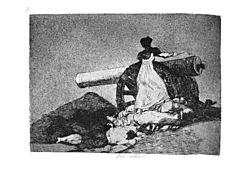
Agustina is the only clearly recognizable person in The Disasters of War, a famous series of drawings by Francisco Goya. Goya himself was from Zaragoza.
Lord Byron wrote many detailed verses about Agustina in his poem Childe Harold. Byron traveled a lot in Europe. His poem suggests that Agustina's brave actions were partly because she saw someone she cared about get hurt in the battle. Even though Byron wrote about her before they met, records show they did meet later.
Agustina's life was shown in the 1929 silent film Agustina of Aragon. She was also played by Aurora Bautista in the 1950 film Agustina of Aragon.
See also
 In Spanish: Agustina de Aragón para niños
In Spanish: Agustina de Aragón para niños
- Casta Álvarez
- Juana Galán
- Maria Pita
- Deborah Sampson
- Molly Pitcher
- Francisca Carrasco Jimenez
- Anna Maria Lane
- Giuseppa Bolognara Calcagno


